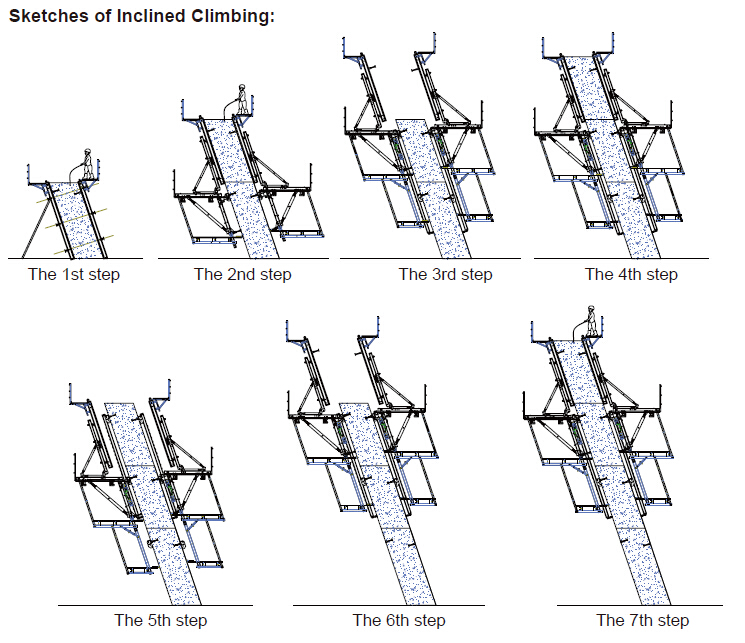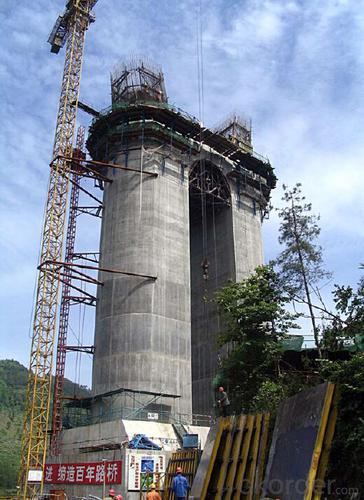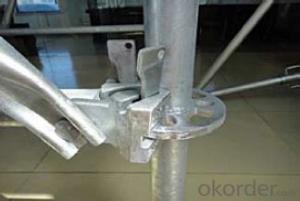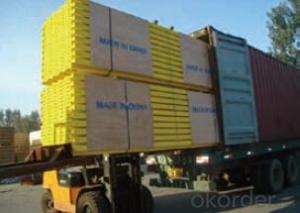Auto climbing bracket ACB100&ACB50 for formwork and scaffolding systems
- Loading Port:
- Tianjin
- Payment Terms:
- TT OR LC
- Min Order Qty:
- 50 m²
- Supply Capability:
- 1000 m²/month
OKorder Service Pledge
OKorder Financial Service
You Might Also Like
Auto-climbing Bracket ACB100 & ACB50
The power of the auto-climbing formwork is the hydraulic system, which includes the oil cylinder
and two commutators. The commutators can control the climbing of climbing rail and the bracket.
The steel rail and the bracket can inter-climbing, so the whole system will climb up steadily.
Cranes are not needed during the construction. It’s easy to operate, highly efficient and safe. It’s
the best choice for the construction of high buildings and bridges.
There are mainly two types of standard auto-climbing brackets, ACB-50 and ACB-100, the figure
means the push power of cylinder with unit of KN.
Characteristics:
◆ Perfect load bearing anchor system
Anchor system is the most important supporting part. The system is made of five parts shown
below. Thereinto, tensile bolt, V-climbing cone and washer can be taken out for reusing after the
concrete pouring finished.There are two kinds of anchor systems,A & B. A is matched with single
anchor shoe and B is matched with double anchor shoe.
◆ Crane-independent
Crane-independent forming, striking and climbing speeds up the work procedures on the
construction site and also makes them independent of each other. This means the planned
sequences can be maintained along with guaranteeing high productivity levels. The crane can
therefore be used for other tasks.
Hydraulic system is mainly made of two commutators,
oil cylinder and power distribution system.The
commutators can control the climbing of climbing rail
and bracket.
◆ High bearing capacity and safe
The stable working platforms are able to carry large loads, e.g. the storage of reinforcing steel
for the next climbing section. Generously-sized working platforms, the well thought-out design for
handling very high wind loads and the patented control function of the climbing mechanism are
some of the special details contained within the comprehensive safety concept.
◆ Platforms adjusted to suit the angle of inclination
The horizontal working areas thus created provide safe and comfortable conditions for
reinforcement work, shuttering and striking, concreting and finishing.
◆ The ACB formwork system can climb not only vertically but also slantways, the largest angle is
18 degrees.
◆ The system can climb up wholly or separately. The climbing process is steady, synchronous
and safe.
◆ The bracket will not fall to the ground until the construction is finished, the field will be saved
and the impacting breakage will be reduced (especially the panel).
◆ The system will furnish omnidirectional platform, the construction organizations don’t need to
set up additional operation platform.
◆ The error of structure construction is small and easy to correct.
◆ The climbing speed is fast, the construction course will be quickened.
◆ The formwork can climb itself and cleaning work can be done in the same situs , the used times
of tower crane will be greatly reduced.

- Q: Can steel formwork be used for tunnel construction projects?
- Yes, steel formwork can be used for tunnel construction projects. Steel formwork is highly durable and can withstand the high pressures and harsh conditions typically encountered in tunnel construction. It provides a strong and stable structure for pouring and shaping concrete, ensuring the tunnel's structural integrity. Steel formwork is also reusable, making it a cost-effective and efficient choice for tunnel construction projects.
- Q: How does steel formwork handle concrete shrinkage and cracking?
- Steel formwork is a versatile and durable option when it comes to dealing with concrete shrinkage and cracking. Its design ensures support and stability during the pouring and curing process, effectively minimizing the negative effects of shrinkage and cracking. One of the main benefits of steel formwork is its capacity to withstand the pressure exerted by shrinking concrete. Steel is a resilient material that can resist the forces generated by the drying and hardening of the concrete. As a result, the formwork remains intact and does not deform or collapse under the weight of the shrinking concrete. Moreover, steel formwork often incorporates expansion joints or other flexible components that can accommodate the movement caused by shrinkage and cracking. These joints allow the formwork to expand and contract in sync with the concrete, reducing stress on the structure and minimizing the risk of cracks. Additionally, steel formwork can be easily reinforced or supplemented with additional support elements, like braces or tie rods, to further enhance its ability to handle concrete shrinkage and cracking. These reinforcements ensure the forces exerted by the shrinking concrete are evenly distributed across the formwork, decreasing the likelihood of localized cracking or structural failure. In summary, steel formwork is a reliable and robust solution for effectively managing concrete shrinkage and cracking. Its strength, flexibility, and capacity for reinforcement make it an ideal choice for construction projects where minimizing the impact of these issues is of utmost importance.
- Q: Does steel formwork require special equipment for installation?
- Yes, steel formwork does require special equipment for installation. This can include cranes, forklifts, and other heavy machinery to lift and position the steel formwork panels accurately. Additionally, specialized tools like tie rods, clamps, and brackets may be necessary to secure the formwork in place during the concrete pouring process.
- Q: Can steel formwork be used for theater construction projects?
- Yes, steel formwork can be used for theater construction projects. Steel formwork refers to temporary or permanent molds made of steel that are used to shape and support concrete during the construction process. It is a versatile and durable formwork material that can be used for various construction projects, including theater construction. Steel formwork offers several advantages for theater construction projects. First, it provides a high level of strength and stability, ensuring that the concrete structures built for theaters are sturdy and long-lasting. This is particularly important in theaters, where safety is a top priority due to the large number of people that gather in these spaces. Additionally, steel formwork allows for intricate and complex designs to be achieved, which is often required in theater construction. The flexibility of steel formwork enables the creation of customized shapes, curves, and patterns, allowing architects and designers to bring their creative vision to life. Moreover, steel formwork is reusable, which makes it a cost-effective option for theater construction projects. Unlike traditional wooden formwork that needs to be replaced after a single use, steel formwork can be used multiple times, reducing material and labor costs. Lastly, steel formwork offers a faster construction process. Its ease of assembly and disassembly speeds up the construction timeline, allowing theater projects to be completed in a shorter time frame. In conclusion, steel formwork is a suitable choice for theater construction projects due to its strength, versatility, flexibility, reusability, and efficiency. It offers numerous benefits that contribute to the successful and timely completion of theater construction projects.
- Q: How does steel formwork handle complex geometries?
- Construction projects can easily manage complex geometries using steel formwork, which is known for its versatility. Unlike traditional wooden formwork, steel formwork is custom-made to fit the project's specific requirements, allowing for the creation of intricate and complex shapes. Modular components are used to construct steel formwork, which can be assembled and adjusted to accommodate various geometric configurations. This flexibility enables it to handle challenging shapes like curves, arches, and irregular structures, which would be difficult to achieve with other types of formwork. In addition, steel formwork offers superior strength and stability, allowing it to withstand the pressure exerted by the concrete during pouring and curing. This strength enables the construction of tall and complex structures without compromising the integrity of the formwork system. Furthermore, steel formwork can be easily reused multiple times, making it a cost-effective solution for managing complex geometries. Its durability and resistance to wear and tear ensure that it can be used for numerous projects, further enhancing its economic viability. Moreover, steel formwork provides a smooth and consistent finish to the concrete surface, resulting in high-quality end products. This is especially important when dealing with complex geometries, as any imperfections or inconsistencies could be more noticeable. In conclusion, steel formwork is a reliable and efficient solution for managing complex geometries in construction. Its versatility, strength, reusability, and ability to provide a smooth finish make it an ideal choice for projects with intricate and challenging shapes.
- Q: What are the different types of steel formwork systems?
- Construction projects commonly utilize various types of steel formwork systems, which serve as temporary structures or molds to support concrete during pouring and curing. Below are several types of steel formwork systems commonly used: 1. Traditional steel formwork: This prevalent system involves connecting individual steel panels using clamps or pins. These panels can be adjusted to create different shapes and sizes, and they are straightforward to assemble and disassemble. 2. Modular steel formwork: This system relies on prefabricated steel modules that are interconnected to form larger formwork assemblies. The modules are lightweight and easy to handle, making them ideal for repetitive use in projects with consistent shapes and sizes. 3. Tunnel formwork: Specifically designed for tunnel or underground structure construction, this system utilizes interconnected steel panels to create a seamless, continuous mold. It is commonly employed in large-scale infrastructure projects like subway systems or underground parking garages. 4. Climbing formwork: This system is suitable for tall structures such as high-rise buildings or towers. It comprises vertically extendable steel formwork panels that are attached to a climbing mechanism. This mechanism facilitates lifting and repositioning of the panels at each level, enabling uninterrupted construction. 5. Slip formwork: For vertical structures like walls or columns, slip formwork is utilized. It involves a moving formwork that is continuously filled with concrete as it ascends. Steel rods or cables support the formwork, allowing for the swift construction of tall and straight structures. These examples represent only a portion of the diverse steel formwork systems available. The selection of the most suitable system depends on the project's specific requirements, including structure size, shape, complexity, desired construction speed, and cost-effectiveness.
- Q: How does steel formwork affect the overall cost-effectiveness of a construction project?
- Steel formwork can significantly enhance the cost-effectiveness of a construction project due to its durability and reusability. Its strength allows for multiple reuses, reducing the need for frequent replacements and thereby decreasing material and labor costs. Moreover, steel formwork facilitates faster construction processes, minimizing labor expenses and project duration. Additionally, its higher quality finish reduces the need for additional finishing work, resulting in further cost savings. Overall, steel formwork's longevity, efficiency, and reduced maintenance costs make it a cost-effective choice for construction projects.
- Q: Can steel formwork be used for concrete beams with varying cross-sections?
- Yes, steel formwork can be used for concrete beams with varying cross-sections. Steel formwork is highly versatile and can be easily adjusted and customized to accommodate different shapes and sizes of concrete beams. It offers flexibility in terms of formwork design and allows for the creation of complex and irregular shapes. Additionally, steel formwork provides excellent strength and durability, making it suitable for supporting the weight and pressure exerted by concrete during the pouring and curing process. Overall, steel formwork is an ideal choice for constructing concrete beams with varying cross-sections, as it offers adaptability, strength, and reliability.
- Q: How does steel formwork handle different concrete pumping methods?
- Steel formwork offers a versatile and long-lasting solution for managing different concrete pumping methods. It is specifically designed to endure the pressure and force exerted during the pumping process, making it suitable for a range of pumping techniques. One widely used concrete pumping method involves the use of boom pumps, which employ a flexible or telescopic boom to reach the desired location. Steel formwork easily accommodates this method by providing a stable and secure surface for the boom pump to rest on. The strength and rigidity of steel ensure that the formwork remains intact and can withstand the weight and vibrations generated by the pumping process. Another popular pumping method is line pumping, which relies on a series of pipes and hoses to transport concrete to the intended location. Steel formwork is compatible with this method as well, as the pipes and hoses can be securely fastened to the formwork using clamps or brackets. The formwork acts as a support system for the pipes, ensuring they stay in place and can effectively transport the concrete without any disruptions. Furthermore, steel formwork can accommodate other concrete pumping methods like trailer-mounted pumps or truck-mounted pumps. These methods involve the use of portable pumps that can be easily moved to different locations. Steel formwork can be conveniently repositioned or adjusted to cater to the pump, providing a stable and dependable platform for the pumping process. In conclusion, steel formwork is a suitable choice for managing different concrete pumping methods due to its strength, stability, and adaptability. It effectively supports the equipment used in various pumping techniques, resulting in a seamless and efficient concrete placement process.
- Q: Can steel formwork be used for elevated slabs?
- Yes, steel formwork can be used for elevated slabs. Steel formwork is a versatile and durable option for constructing elevated slabs. It provides a strong and rigid structure that can support the weight of the slab and any additional loads. Steel formwork also offers the advantage of being reusable, allowing for cost savings and efficiency in construction projects. Additionally, steel formwork can be easily adjusted and customized to meet specific design requirements, making it suitable for various types of elevated slabs. Overall, steel formwork is a reliable option for constructing elevated slabs due to its strength, durability, reusability, and versatility.
Send your message to us
Auto climbing bracket ACB100&ACB50 for formwork and scaffolding systems
- Loading Port:
- Tianjin
- Payment Terms:
- TT OR LC
- Min Order Qty:
- 50 m²
- Supply Capability:
- 1000 m²/month
OKorder Service Pledge
OKorder Financial Service
Similar products
Hot products
Hot Searches


















